Physical Address
304 North Cardinal St.
Dorchester Center, MA 02124
Majority of patients with patellofemoral disorders respond favorably to conservative measures.
Surgery required for recalcitrant cases with specific anatomic abnormalities that require correction.
Patellar malalignment: a translational or rotational deviation of the patella relative to any axis.
Proximal realignment procedures alter the medial-lateral position of the patella through balancing of soft tissue restraints proximal to its inferior pole.
Distal realignment procedures modify the medial-lateral, anterior-posterior, external rotation, and proximal-distal positions of the patella by transfer of the tibial tubercle.
Operative procedures to be described:
Modification of Elmslie-Trillat procedure: arthroscopic lateral release if a contracted lateral retinaculum is present, a modified VMO advancement, and a modified medial transfer of the tibial tubercle.
MPFL reconstruction using the quadriceps tendon based on the proximal patella, combined with a distal realignment procedure when indicated.
Correction patella alta.
ITB lengthening.
Types of extensor mechanism problems:
Diffuse anterior knee pain without distinct anatomic abnormalities in alignment, subluxation, or joint damage: treated conservatively.
Anterior knee pain with mild to moderate abnormalities: treated conservatively.
Patellofemoral pain with definite anatomic signs of an extensor mechanism malalignment: candidates for surgery.
First-time patella dislocation treatment categories:
Anatomic abnormalities (congenital laxity MPFL, increased Q-angle, trochlear dysplasia): treated conservatively; candidates for surgery if symptomatic.
± Underlying anatomic abnormalities, major joint hemarthrosis, MRI evidence of patellar or femoral osteochondral fracture: surgery, fixation fracture, MPFL repair.
Conservative treatment; reevaluate stability after acute injury.
Disorders of the extensor mechanism, including the patellofemoral joint, are some of the most common causes of anterior knee pain related to inflammation of the parapatellar soft tissues, articular cartilage damage, and instability (subluxation, dislocation). Although the majority of patients respond favorably to conservative measures, surgical treatment is required for recalcitrant cases with distinct anatomic abnormalities that require correction. The key to the indications for surgical treatment is the diagnosis of the specific anatomic defects that cause the patient's symptoms. This underscores the importance of the history and physical examination discussed later in this chapter.
The terminology used to describe patellofemoral disorders in the literature can be confusing. Patellar malalignment may be defined as a translational or rotational deviation of the patella relative to any axis. It is caused by an abnormal relationship among the patella, the soft tissues surrounding the patella, and the femoral and tibial osseous structures. The source of such abnormal patellar kinematics may be peripatellar tissue tightness or laxity; osteochondral dysplasias, such as a shallow or convex trochlear groove; bony abnormalities of the patella; rotational malalignment of the femur and tibia proximal and distal to the knee joint; an excessive proximal or distal position of the patella relative to the trochlea (patella alta and patella baja); and inflexibility or weakness of the quadriceps, hamstrings, and iliotibial band (ITB).
Many surgical procedures have been described for realignment of the patellofemoral mechanism, including proximal realignment procedures, distal realignment procedures, or a combination of both. Proximal realignment procedures alter the medial-lateral position of the patella through balancing of soft tissue restraints proximal to its inferior pole. Included in this category are lateral retinacular release, medial retinacular capsular and medial patellomeniscal (MPML) plication, vastus medialis obliquus (VMO) advancement, and medial patellofemoral ligament (MPFL) repair or reconstruction. Distal realignment procedures modify the medial-lateral, anterior-posterior, rotations, and proximal-distal positions of the patella by transfer of the tibial tubercle. Included in this category are anterior (Maquet ), medial (Elmslie-Trillat ) and anteromedial (Fulkerson ) transfer of the tibial tubercle. Literally hundreds of articles have been written on these operative procedures regarding their indications, technique, and clinical outcome, and the reader is referred to review articles for further information.
The purpose of this chapter is to provide an algorithm of the surgical treatment of specific patellofemoral disorders. Because this is an evolving surgical field, we recognize that there are many approaches and strategies to the treatment of these problems published in the review articles cited previously. In this chapter, the technique of a proximal and distal patellar realignment, a modification of Elmslie-Trillat procedure, is described. It includes an arthroscopic lateral release if a contracted lateral retinaculum is present, soft tissue balancing of medial restraints, and a modified medial transfer of the tibial tubercle when necessary. The goals of these procedures are to release abnormal lateral tethering tissues when present, provide a balanced medial tissue–ligament complex, and realign the quadriceps-patella–tibial tubercle relationship. The procedures are performed using cosmetically appealing incisions with rapid rehabilitation, immediate knee motion, early weight bearing, and early return to function.
The second operative procedure described in detail is a MPFL reconstruction using the quadriceps tendon (QT) based on the proximal patella. This procedure is performed through a limited cosmetic incision and avoids harvesting the semitendinosus tendon, use of an allograft, and bony fixation at the patella or medial femoral attachment. This procedure has proven to be useful in revision cases that failed after a proximal realignment in which an inadequate MPFL was not addressed. The operative procedure is combined with a distal realignment when indicated, as is discussed. Other operative procedures the senior author (F.R.N.) has found useful for correcting patella alta and ITB lengthening are also described. Surgical procedures for rotational malalignment of excessive femoral anteversion and external tibial torsion are discussed in Chapter 36 and are not repeated here.
The majority of patients with patellofemoral malalignment respond favorably to conservative treatment programs, covered in detail in other publications. In general, three types of extensor mechanism problems present for treatment. The first group of patients have diffuse anterior knee pain without distinct anatomic abnormalities in alignment, subluxation, or joint damage that can be identified. Commonly, these are younger athletes who are involved in multiple sports, and frequently, the only finding is the presence of tenderness of peripatellar soft tissues and the anterior fat pad tissues. On occasion, a mild joint effusion may be present. Authors have stressed that these symptoms frequently represent an overuse condition from excessive participation in athletics. Treatment consists of allowing the soft tissues time to heal and inflammation to recede by modification of athletics followed by appropriate strengthening and stretching of the muscle groups. Specific factors that may contribute to the symptomatic state include excessive conditioning, type of sport, and duration and frequency of athletic participation. Recurrence of symptoms is not an indication for surgical treatment because distinct anatomic abnormalities of the extensor mechanism are not present. A cartilage-sensitive magnetic resonance imaging (MRI) may be helpful in recurrent symptomatic knees to determine the status of the patellofemoral joint and presence of early articular cartilage damage that is aggravated by vigorous athletic activities.
There is a second group of patients with anterior knee pain that are similar in all aspects to the first group described previously, except that mild to moderate abnormalities are detected on the physical examination. For example, there may be a lateral subluxation (lateral glide) up to 50% of the patellar width and a mild to moderate increase in the Q-angle. There may be a physiologic posterolateral ligament laxity allowing increased external tibial rotation during activities (dynamic Q-angle). These patients are also treated conservatively and are not candidates for extensor mechanism realignment surgery.
The third group consists of patients who demonstrate definite anatomic signs of an extensor mechanism malalignment who are candidates for surgery. An example is patients with symptomatic lateral patellofemoral subluxation events who do not respond to conservative treatment and have a deficient MPFL. Included in this group are patients who have had a prior patellofemoral dislocation and remain symptomatic, either with recurrence of lateral patellofemoral subluxation or a repeat dislocation event.
Nonoperative treatment of first-time patella dislocations has a redislocation rate that ranges from 14% to 57% in adult populations and from 36% to 71% in pediatric populations. Stefancin and Parker conducted a systematic review of 70 articles that focused on the management of traumatic first-time patellar dislocations and concluded that conservative treatment was indicated initially except in specific circumstances. These included the finding of an osteochondral fracture, a substantial disruption of the MPFL, a laterally subluxated patella with normal alignment of the contralateral knee, or after failed conservative treatment or recurrent dislocations. In a study that analyzed factors associated with patellar dislocations in 40,544 injured knees in the United States, Waterman and colleagues reported that the peak incidence of injury occurred between 15 and 19 years of age, and 52% occurred during athletics.
Patients with an acute lateral first-time dislocation are separated into three categories:
Dislocation with underlying anatomic abnormalities such as congenital laxity of the MPFL, increased Q-angle, and trochlear dysplasia, with similar abnormalities present in the opposite extremity. These patients undergo conservative treatment and are candidates for surgery if symptoms occur in the future. These patients require an MPFL reconstruction because the hyperlaxity indicates deficiency of the medial soft tissue stabilizers. This surgery is not indicated in an acute knee injury situation and may be performed on an elective basis after the patient has recovered muscle function and conditions are more ideal for surgery.
Dislocation with or without underlying anatomic abnormalities, as detailed previously, in which there is a major joint hemarthrosis and MRI evidence of a well-defined or probable patellar or femoral osteochondral fracture. These patients require arthroscopic examination, removal of loose bodies, and fixation of a large osteochondral fracture when present (rare). Only under rare conditions is an MPFL repair performed, when MRI helps define the location of the tear at the patellar attachment. The majority of MPFL tears represent an interstitial disruption throughout its substance or demonstrate a combination of tears at attachment sites and are not amendable to acute repair.
Dislocation without distinct trochlear or patellar tendon insertion abnormalities in which the primary defect is an acute disruption of the medial retinacular restraints and the MPFL. In an athletic patient desiring an early return to athletics, an MPFL repair of a well-defined patella or femoral attachment tear has been advocated in some studies. Less clear are indications for acute repair of MPFL tears that are interstitial without a patella or femoral attachment tear. These interstitial tears have the ability to heal by conservative treatment and may not require further surgery. Accordingly, the senior author refers to treat these dislocations initially in a conservative manner without surgical MPFL repair.
In a majority of chronic knees with recurrent bilateral patellar subluxation or dislocation, patient education is essential to explain the goals of the operative procedure. Patients are advised that any associated articular cartilage damage will likely cause future symptoms that limit athletic participation even though the recurrent patellar instability has been successfully treated.
Primary contraindication surgery: absence of a distinct anatomic defect.
Excessive hip anteversion or abnormal external tibial torsion.
Distal realignment contraindicated in skeletally immature patients.
Patellofemoral arthritis is a relative contraindication; however, in select knees, a realignment procedure is indicated along with a cartilage restoration procedure.
Severe lower limb muscle atrophy.
Obesity.
The primary contraindication for extensor mechanism malalignment surgery is the absence of a distinct anatomic defect because the goal of surgery is to restore as well as possible normal alignment of the extensor mechanism. The presence of chronic recurrent anterior knee pain is not an indication for surgery when the specific etiology of the pain symptoms cannot be determined. This point is worthy of emphasis because many patients present with anterior knee pain in which the specific diagnosis is not apparent despite a thorough and careful examination and evaluation. It is probable that there are pain generation factors related to early patellofemoral cartilage deterioration that are in the initial stage of the disease course. Alternatively, peripatellar and intraarticular soft tissues may be an explainable source of pain. A common cause of unexplained pain is a subtle infrapatellar neuroma or neuritis of the sensory nerves about the knee joint, discussed in Chapters 39 and 40 .
A specific contraindications to extensor mechanism surgery is the presence of excessive hip anteversion or abnormal external tibial torsion as discussed in Chapter 36 . An MRI or computed tomography (CT) scan for axial rotation of the lower extremity from the hip to the ankle is required. The measurements obtained include femoral anteversion, tibial tubercle offset, trochlear groove, and external tibial torsion as are described. The anterior knee pain is caused by excessive lateral patellofemoral forces induced by external tibial torsion or increased femoral anteversion ( Fig. 35-1 ). In these patients, a femoral or tibial derotation osteotomy may be indicated and not a proximal or distal patellofemoral procedure.
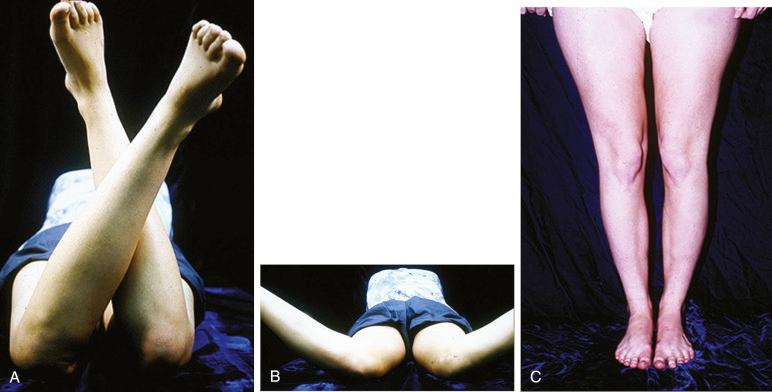
A distal realignment is contraindicated in the skeletally immature patient. However, a proximal realignment that may include a QT autograft (for deficient, thin MPFL and retinaculum) may be performed because there is no drilling of osseous tunnels. In cases of recurrent dislocation in a skeletally immature patient, even with an abnormal lateral patellar tendon insertion offset (increased Q-angle), the MPFL reconstruction is usually very successful in providing patellar stability. After growth is complete, the need for correction of the lateral patellar tendon tibial tubercle attachment may be assessed, which is frequently not required in our experience.
A relative contraindication is the presence of patellofemoral arthritis; however, in select knees, a realignment procedure may be performed with a cartilage restoration procedure.
Often, patients with chronic extensor mechanism malalignment disorders have limited their activity, gained excessive body weight and have articular cartilage damage that limits rehabilitation. These problems cause muscle atrophy of the entire lower extremity. These patients require a comprehensive evaluation and team approach involving nutrition counseling, weight reduction to normal indices, prolonged rehabilitation, occupational rating and modification, and management of patellofemoral pain before any consideration of surgery. An abnormal body mass index in a patient with symptomatic patellofemoral cartilage damage contraindicates extensor mechanism surgery.
Factors influencing patellar stability: geometry trochlear groove, dynamic muscle actions, passive soft tissue restraints, angle knee flexion.
Methods to measure patellar mobility: manual, instrumented, radiographic
Patella most unstable at 0-30 degrees of knee flexion.
Shallow or dysplastic trochlear groove allows patella to displace more easily.
Patella alta results in a loss of the trochlea geometric restraint until 30-40 degrees of flexion.
MPFL primary restraint to lateral patellar translation, providing 53%-67% restraint up to 30 degrees of knee flexion.
Mean failure load of the MPFL 208 N.
Multiple factors influence patellar stability, including articular geometry, dynamic muscle actions, and passive soft tissue restraints. The geometry of the trochlear groove, the height and slope of the lateral femoral condyle, and the angle of knee flexion all affect lateral patellar translation. Amis described objective patellar stability in terms of two factors: the amount of force required to displace the patella on a given linear distance from its equilibrium position (translation) or the turning moment required to induce a rotation, such as a lateral tilt. Methods used to determine patellar mobility include manual measurement, instrumented quantitative measurement, and radiographic measurement. Kolowich and coworkers measured patellar glide by dividing the patella into four quadrants and describing medial and lateral mobility as a fraction of patellar width. Normal subjects had less than two quadrants of translation with the knee flexed 30 degrees. Teitge and associates developed a stress radiographic method to measure patellar medial-lateral stability. Knees of normal subjects and symptomatic patients were tested between 30 and 40 degrees of flexion with 71 N of force applied. Wide variation was noted in the normal knees because lateral displacement ranged from 1 to 32 mm, and medial displacement ranged from 2 to 22 mm. The mean difference in lateral displacement between the right and left knees was 1.3 ± 1.1 mm, and the mean difference in medial displacement was 1.2 ± 1.08 mm. The investigators determined that a difference between knees in lateral displacement of 3.7 mm, or a difference in medial displacement of 3.5 mm, was abnormal.
Hautamaa and colleagues developed an instrumented measurement device to determine patellar medial-lateral translation in the coronal plane. In 17 cadaver knees, with the knee flexed 30 ± 5 degrees, 5 lb of laterally directed force produced an average of 9.3 ± 0.9 mm of lateral translation. Instrumented measurement of medial-lateral patellar translation was also conducted by Fithian and coworkers in normal and symptomatic patients. Right versus left knee comparisons revealed small mean differences in the control subjects for medial and lateral patellar translation (30 degrees of flexion, 2.5-lb force, 0.1 ± 1.9 mm, and 0.2 ± 1.0 mm, respectively). Significant differences were found between the control and the symptomatic subjects in the mean differences in lateral translation ( P < .01).
It is well appreciated that the patella is most unstable in the range of 0 to 30 degrees of flexion. When the knee is near full extension, the Q-angle is maximized because of the external rotation of the tibia. In addition, with the quadriceps muscle relaxed, the patella is not engaged in the trochlear groove and thus is easily mobilized in a medial-lateral direction. As the knee is flexed, patellar stability is increased owing to the combined tensions of the quadriceps muscles and the patellar tendon that pull the patella into the trochlear groove. A shallow or dysplastic trochlear groove allows the patella to displace more easily. A patella alta condition results in a loss of the trochlea geometric restraint until 30 to 40 degrees of flexion when patellotrochlear contact finally occurs.
In regard to passive soft tissue restraints, the MPFL is the primary restraint to lateral patellar translation, providing 53% to 67% restraint up to 30 degrees of flexion. Desio and associates examined nine cadaver knees (mean age, 57 years; range, 43-70 years) at 20 degrees of flexion and reported that the MPFL provided a mean of 60% of the restraining force to lateral patellar translation. The MPML provided a mean of 13% of the restraining force; the lateral retinaculum, 10%; and the medial retinaculum and medial patellotibial ligament, 3% each. Conlan and colleagues reported similar findings from 25 cadaver specimens ( Fig. 35-2 ); the MPFL provided an average of 53% of the total restraining force followed by the MPML (22% contribution), the medial retinaculum (11% contribution), and the medial patellotibial ligament (5% contribution). Sectioning of the MPFL decreased the restraining force significantly; the average stiffness decreased from 225 N/cm in the intact specimens to 104.6 N/cm ( P = .001).
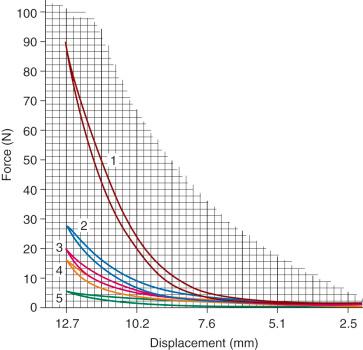
Nomura and coworkers measured the lateral patellar translation in 10 cadaver knees (aged 45 to 60 years) with the quadriceps tensed to 10 N and a lateral force of 10 N applied before and after sectioning of the MPFL. Isolated sectioning of the MPFL significantly increased the lateral patellar translation from 20 to 90 degrees of flexion ( P < .05).
Amis and associates reported a mean failure load of the MPFL of 208 N from 10 cadaveric specimens. However, age effects may bias the results because the mean age was 70 years. These investigators reported the contribution of the MPFL in restraining lateral patellar translation was greatest with the knee at 0 degree extension. Significant increases in lateral translation occurred from 0 to 20 degrees after the MPFL was sectioned ( P value not provided; Fig. 35-3 ).
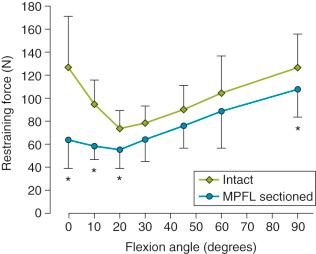
Physical examination:
Palpation of parapatellar soft tissues.
Patellar compression test with knee flexion-extension.
Patellar subluxation, 0 and 30 degrees of flexion, medial-lateral.
Rule out other sources of pain
Lower limb rotational alignment: femoral anteversion, tibial torsion, Q-angle 0 and 30 degrees of flexion.
CT, MRI: trochlear dysplasia, TT/TG distance, femoral anteversion, tibial torsion.
The physical examination is crucial in preoperative planning for patellar realignment surgery. The examination should be performed with the patient in the standing, sitting, and supine positions (see Fig. 35-1, D to J ). Palpation of parapatellar soft tissues and the fat pad are performed for swelling and elicitation of pain. The examiner should look for evidence of lateralization of the extensor mechanism and tilt. The patellar compression test should be performed with flexion and extension of the knee to evaluate for articular crepitus or pain. Passive patellar tilt and tightness of the lateral retinaculum should be noted. Patellar subluxation tests (patellar glide at 0 and 30 degrees of flexion) should be performed in medial and lateral directions and patellar mobility noted. Other sources of pain such as neuroma, patellar tendonitis, synovial plica, synovitis, meniscus tears, osteochondritis dissecans, complex regional pain syndrome, and advanced tibiofemoral arthritis should be excluded.
Lower limb rotational alignment, including femoral anteversion and tibial torsion, is measured. The Q-angle is the angle formed between one line connecting the anterior superior iliac spine to the center of the patella and a second line connecting the center of the patella to the tibial tubercle. The Q-angle is measured with the knee in 0 and 30 degrees of flexion. The Q-angle arc is measured at 30 degrees with internal and external tibial rotation. Patients with a physiological laxity of the posterolateral ligament structures have an increased lateral patellar tendon deviation by virtue of the increased external tibial rotation. The clinical measurement of the Q-angle can be inaccurate for a number of reasons. If the patella is subluxed laterally, then the central reference point of measurement is also lateral, with a decrease in the Q-angle measurement unless the patella is carefully positioned within the center of the femoral groove. The Q-angle will vary depending on the amount of knee flexion and foot position; it increases with foot pronation and external tibial rotation. The proximal line to the anterior superior iliac spine is only an approximation.
Conventional radiographic techniques are often inadequate for the assessment of patellofemoral malalignment. The most commonly used Merchant technique requires 30 to 45 degrees of knee flexion. The difficulty with this technique and others is that images are not obtained near full extension where the trochlea is most shallow. As the knee flexes, the trochlear groove deepens, and the patella undergoes medialization and becomes more congruent with the femoral sulcus. The extent of trochlear dysplasia and patellar subluxation or tilt may be underestimated on the axial view owing to the amount of flexion required to obtain the image. A lateral radiograph in 30 degrees of flexion may be used to evaluate patellar height, patellar tendon length, and trochlear dysplasia. However, a true lateral radiograph, in which the distal and posterior aspects of the femoral condyles are perfectly superimposed, is required to evaluate trochlear depth, which is measured more accurately on an axial MRI.
Dejour and associates analyzed the radiographs and CT scans of 143 knees with symptomatic patellar instability and 67 contralateral asymptomatic knees to determine the factors affecting patellar instability. These authors reported that trochlear dysplasia was present in 96% of unstable patellas. Dejour and colleagues described a qualitative classification system of four types of trochlear dysplasia: type A, trochlear morphology preserved with a fairly shallow trochlea; type B, flat or convex trochlea; type C, asymmetry of trochlear facets with convex lateral facet and hypoplastic medial facet; and type D, asymmetry of trochlear facets and cliff pattern. Many years later, Nelitz and coworkers evaluated MRI criteria of 80 knees with symptomatic patellofemoral instability to determine whether specific measurements of the femoral trochlea could be assigned to Dejour's classification system. Given the marked variation in trochlear morphology, none of the quantitative MRI measurements could be assigned to this system. A similar conclusion was reached in a study by Lippacher and associates, who also noted that lateral radiographs underestimated the severity of trochlear dysplasia compared with axial MRI.
Nelitz and coworkers reported median values of eight trochlear indices that distinguished Dejour type A (low-grade dysplasia) from the higher grade dysplasia categories (B-D) and, based on their findings, recommended that a two-grade system be used instead of a four-grade system. The cut-off values between low- and high-grade dysplasia were 2 mm for depth of the trochlear groove, 48% for trochlear facet asymmetry, and 11 degrees for lateral trochlear inclination.
CT and MRI have been used to assess lower limb rotational alignment and are important tests for a complete diagnosis of the anatomic abnormalities that may be present. These studies obtain axial images of the patellofemoral joint at or near full extension to evaluate trochlear dysplasia and the tibial tubercle/trochlear groove (TT/TG) distance. Various investigators have studied this distance and found that it may be increased in patients with patellofemoral pain and instability.
Femoral anteversion has been measured by a variety of techniques by many authors. Yoshioka and Cooke measured anteversion from the bone in 32 femora and reported a mean of 13.1 ± 8 degrees (range, −11 to +22 degrees) in both males and females when the distal measurement was the tangent across the femoral condyles and a mean of 7.4 degrees when measured across the epicondyles. These authors conducted a review of the literature on this measurement and found that normal values were between 8 and 16 degrees in 12 different investigations. Teitge and associates arbitrarily selected 13 degrees as the goal for correction (see Chapter 36 ).
The technique for measuring tibial torsion by CT has not been standardized, and wide variation exists in the literature regarding normal values. Yoshioka and colleagues reported a mean lateral tibial torsion of 21 ± 4.9 degrees in males and 27 ± 11.0 degrees in females, a significant difference ( P < .05). Eckhoff and coworkers reported mean tibial “version” of 37.0 ± 1.7 degrees in control knees and 32.8 ± 1.7 degrees in a group of symptomatic knees. Turner measured a mean of 19 ± 4.8 degrees in a control group compared with a mean of 24.5 ± 6.3 degrees in a group with unstable patellas. Sayli and associates reported an average of tibial torsion in females of 31.07 degrees for the right side and 30.02 degrees for the left. For males, the averages were 32.7 and 35.26 degrees for the right and left sides, respectively. Tamari and colleagues conducted a reliability study that examined different methods of measuring tibial torsion. The results showed that clinical methods currently available do not accurately measure true torsion of the femur and tibia. The authors stressed that, even so, these methods may be useful for screening and descriptive purposes as indices of true torsion, and use of different reference axes could improve their reliability.
MRI has some advantages over CT, including improved ability to image cartilaginous structures, better anatomic approximation of the trochlear articular cartilage groove, and avoidance of radiation exposure. MRI also provides meaningful information about all of the soft tissue structures about the knee joint. The MRI is obtained in standard fashion, with images obtained of the hip parallel to the femoral neck and axial images obtained of the knee and ankle ( Fig. 35-4 ). These individual images are then measured based on the techniques described by Murphy and coworkers and Guenther and associates ( Figs. 35-5 and 35-6 ).
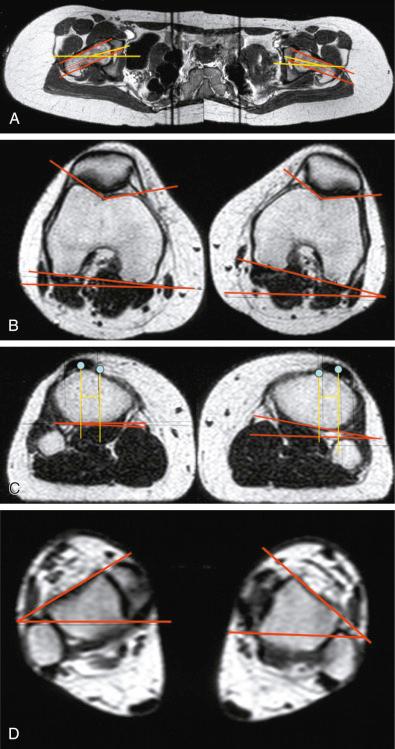

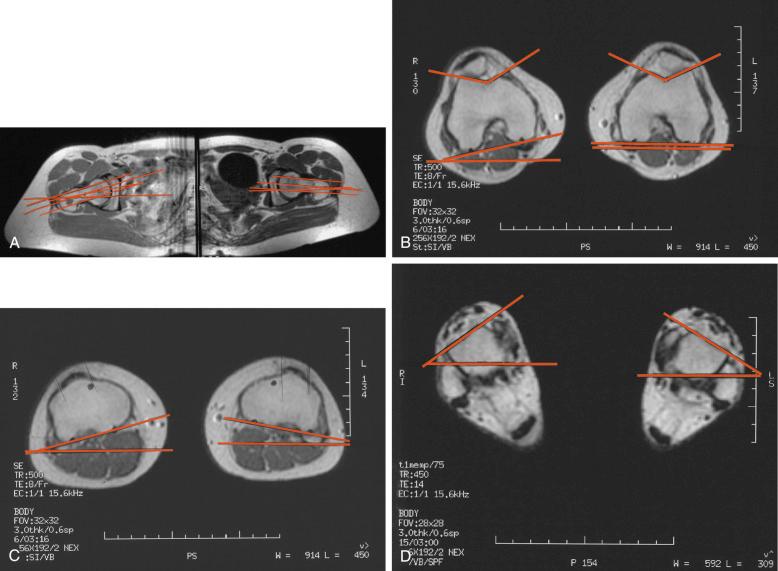
The angle between the femoral neck and the horizontal line is subtracted from the positive angle of the posterior portion of the distal femoral condyle. In rare cases, the rotation of the femoral neck and posterior femoral condyle are in opposite directions, which necessitates addition for the true femoral anteversion. The version of the knee is measured by adding or subtracting the posterior femoral angle (to the horizontal) from the proximal tibial angle (angle between the posterior aspect of the proximal tibia and the horizontal line). The tibial torsion is the difference between the proximal tibial angle and the anterior talus from the horizontal line. Chapter 36 provides a comprehensive analysis of the different anatomic landmarks and normal values that have been measured to define tibiofemoral rotational alignment and their important effects on the patellofemoral joint.
TT/TG is measured using the trochlear groove–patellar tendon insertion distance. TT/TG is measured in millimeters and is the difference from the center of the deepest point of the femoral groove to the center of the patellar tendon attachment to the tibial tubercle. This is done by superimposing the line perpendicular to these points and measuring the distance between the two lines, adjusting for magnification. Dejour and Walch reported a mean TT/TG distance of 12.7 ± 3.4 mm in a group of asymptomatic knees. In a group of knees with patellar instability, the mean TT/TG distance significantly increased to 19.8 ± 1.6 mm ( P < .001). The authors concluded that the pathologic threshold is 20 mm, which has been agreed upon by others. In some knees with trochlear dysplasia, it is difficult to determine the true center point for the measurement, rendering the TT/TG offset to be inaccurate. In these knees, this measurement cannot be used as an evaluation measurement of the desired operative correction.
The TT/TG plays a role in estimating the amount of correction required at the time of the tibial tubercle realignment procedure. Intraoperatively, it is easier to accomplish linear corrections (in millimeters) than to assess angular relationships (in degrees), as in the Q-angle measurement. Importantly, this helps to prevent excessive medial translation of the tibial tubercle. The TT/TG measurement may not reflect the lateral deviation of the patellar tendon attachment with knee flexion and external tibial rotation and therefore the MRI measurements must be correlated with the physical examination. The tibial tubercle abnormality may also involve both a lateral translation and outward (external rotation) orientation.
Operative extremity signed by patient and surgeon with nursing personnel present.
Patient's name, procedure, allergies, preoperative antibiotics, special precautions given and agreed upon by the surgeon, anesthetist, and nursing personnel.
Under anesthesia, the peripatellar retinaculum, patellofemoral crepitation, patellar tilt, passive medial-lateral patellar glide (0, 30 degrees of flexion), Q-angle assessed.
Articular cartilage lesions evaluated; loose flaps debrided.
Lateral retinacular release
Only performed if patellar medial subluxation test is abnormal (patellar medial subluxation ≤8 mm on manual medial translation test, knee at 30 degrees of flexion).
Subcutaneous pouch created with a scissor from the anterolateral portal.
Arthroscopic retinacular release performed with commercial radiofrequency wand through anterolateral portal.
Initiated from 9 o'clock position (right knee); continued distally to 1 cm below inferior pole of patella with the knee in full extension.
Patellar medial subluxation test performed at 30 degrees of flexion.
If the release is inadequate, it is extended proximally to a 10 o'clock position.
Determine that there is no abnormal restraint to lateral patellar glide at 20-30 degrees of flexion, confirm absence of tight lateral tissues at 90 degrees.
Proximal realignment
3-cm vertical skin incision made along medial aspect of the patella.
Medial parapatellar incision made through medial retinaculum.
Superficial and deep retinaculum MPFL incised, 2-3 cm of VMO insertion into patella detached.
Quality of MPFL and medial retinaculum inspected.
Extensor mechanism reconstructed with medial plication of VMO and MPFL so that the VMO advancement is in line with its fibers and prior insertion.
VMO tissue sleeve is translated laterally and imbricated in a vest-over-pants fashion.
Suture placed at 1 o'clock position (right knee) so that the distal part of the VMO is brought laterally in the line of its attachment to restore normal tension at 30 degrees of flexion.
Suture placed at 2 o'clock position through MPFL and medial patellar insertion.
Suture placed at 4 to 5 o'clock position through MPML and medial retinaculum to plicate these structures in line with their normal patellar attachment.
Final tensioning of sutures 30 degrees of knee flexion, patella centered within trochlea.
Knee is taken through 0-135 degrees to observe normal tracking of the patella.
MPFL reconstruction
See Table 35-1 .
| Preoperative |
|
| Operative Steps |
|
Distal realignment
3-cm vertical skin incision placed lateral to tibial tubercle.
Longitudinal incision made over periosteum along lateral border of patellar tendon.
Planned tibial tubercle osteotomy 15 mm wide, 8 mm thick, and 35 mm in length.
Hole drilled through tibial cortex; four to five holes drilled on anterolateral tibial cortex.
Axial 90 degrees cut made just proximal to patellar tendon insertion.
Drill holes along anterolateral surface of tibia connected using a 1/2-inch osteotome.
Osteotome carried through medial cortex directly adjacent to tibial tubercle.
Bone fragment mobilized and translated medially 8-10 mm based on measurements.
Tibial tubercle secured with a 3.2-mm drill bit.
When a proximal advancement is also performed, medial plication and reconstruction completed.
Patellar glide, tracking assessed, Q-angle measured 0 and 30 degrees of flexion.
Final fixation tibial tubercle three 4-mm cancellous screws
Lateral patellofemoral (iliopatellar tract) reconstruction
Indicated symptomatic medial patellar subluxation, manual medial glide at 30 degrees of flexion grossly positive.
Goal restore lateral muscle function by reattachment of the VLO if possible and reconstruct lateral soft tissue restraints.
Dissect VLO attachment to the quadriceps tendon and patella.
Reattach VLO to lateral border of the quadriceps tendon.
Dissect distal VLO tendon proximally, reattach VLO as distally as possible to restore normal anatomy.
Knee flexed 135 degrees.
Semitendinosus tendon autograft used to reconstruct lateral soft tissue restraints when deficient
Tendon placed through a lateral patellar tunnel (10 mm) which enters and exits at the one third and two thirds junction points along the vertical height of the patella.
Tendon ends sutured, length 25 mm.
Incision made junction of iliopatellar tract and iliotibial band.
Usual site for graft is posterior just above the lateral intermuscular septum and proximal to the lateral epicondyle; isometric position, checked by suture at two attachment sites during 0-135 degrees of knee flexion.
Drill hole placed; Beath pin used to pass the two ends of the tendon into the tunnel.
Graft lightly tensioned with knee at 30 degrees of flexion; allow a normal 10-12 mm manual medial glide.
Soft tissue interference screw used for fixation.
Patella alta correction
See Table 35-3 .
The operative extremity is signed by the patient and surgeon with nursing personnel present. A time-out is performed with the patient's name, procedure, allergies, preoperative antibiotics, special precautions given and agreed upon by the surgeon, anesthetist, and nursing personnel.
The patient is positioned supine on the operating table. Under anesthesia, the peripatellar retinaculum, patellofemoral crepitation, patellar tilt, passive medial-lateral patellar glide (at 0, 30 degrees of knee flexion), and Q-angle are assessed and compared with preoperative measurements. A sterile thigh tourniquet is applied as proximal as possible, so that an intraoperative assessment of the Q-angle can be made. Routine diagnostic arthroscopy is performed, and any intraarticular pathology is evaluated and treated. Particular attention is paid to patellar position, mobility, tracking and articular surface. Approximately one fourth of the patella should establish trochlear contact at 0 to 5 degrees of knee flexion. The medial and lateral translation of the patella is assessed at 0 and 30 degrees of knee flexion ( Fig. 35-7 ). This is an important test because a lateral translation of the patella greater than 50% of its width indicates incompetency of the MPFL. The medial translation of the patella tests for lateral retinacular tightness, and a normal lateral translation of 10 to 12 mm should be obtained with the knee at 30 degrees of flexion. The patella and femoral groove are assessed for articular cartilage pathology or dysplasia. Articular cartilage lesions are evaluated for nature, location, and depth. The finding of loose flaps of articular cartilage requires a careful debridement; otherwise, fibrillated cartilage is left alone as it is possible to produce further damage by the debridement procedure. Radiofrequency cartilage debridement devices are never used, because excessive cartilage damage occurs. Most important at the time of arthroscopy is the critical assessment of whether the realignment procedure will transfer the loading from soft or fragmented articular surface to an intact or less involved cartilage surface. The articular cartilage is graded by the classification system described in Chapter 44 .
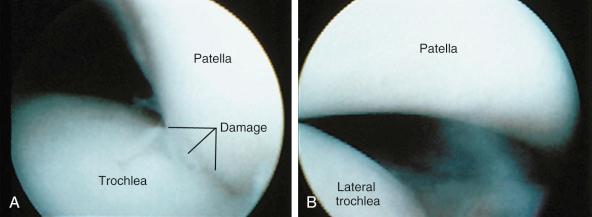
Become a Clinical Tree membership for Full access and enjoy Unlimited articles
If you are a member. Log in here